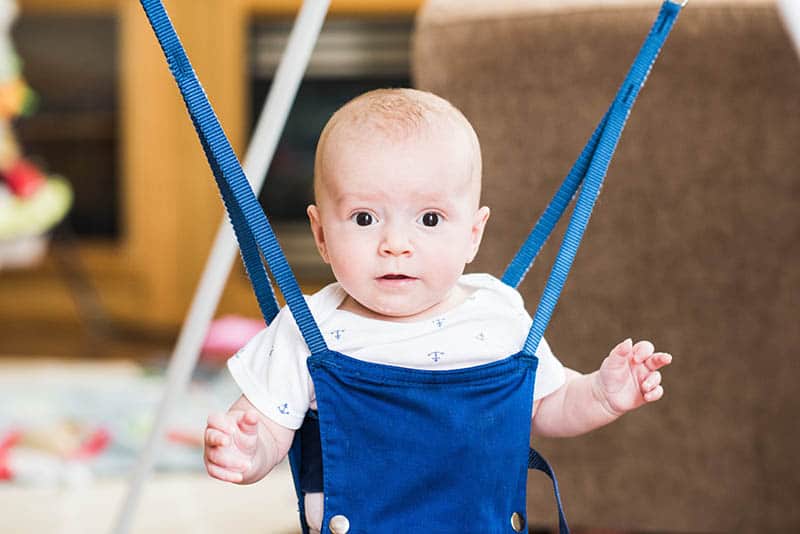Jumpers, bouncers, jumperoos – no matter what you call them, you know just how much fun they can bring to your little one! But there is one important question regarding their use – is there a baby jumper age limit?
In short, yes there is. Most jumpers are built for babies who are at least 4 months old and should not be used after the baby learns how to walk – around 9 months of age – as her curious little legs could try to climb out!
But age is not the only factor to look out for when picking a jumper for your precious baby.
You should take into account her weight, height, and whether she has the muscle strength to hold herself up without your help.
After all, playing in a jumper should be fun for your baby and not uncomfortable.
Plus, you will get some of that extremely valuable hands-free time to do whatever you want! (Even if it’s just texting back your friends without a baby at your hip…)
So, read on to get all the details on the baby jumper age limit, useful safety tips, and a handy buying guide!
What Is The Best Age For A Baby Jumper?
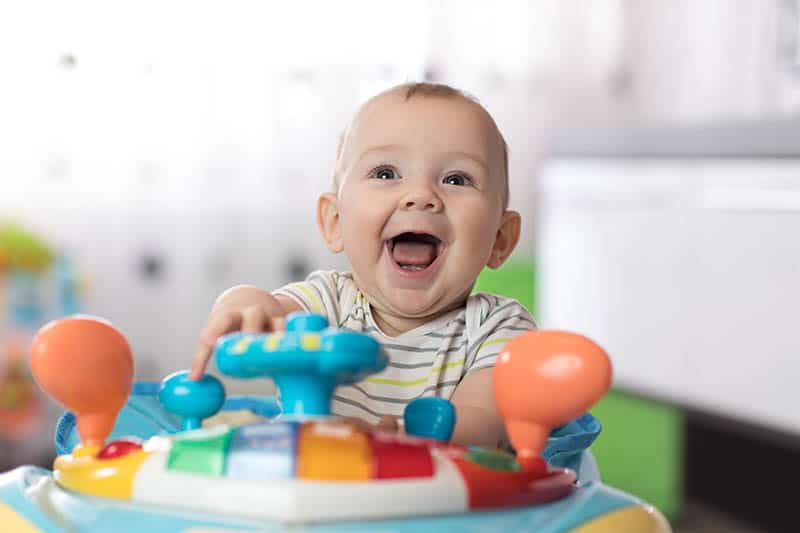
- age
- weight
- height
- baby’s overall development
When you start looking for a jumper for your little one, you will find that most manufacturers offer their own guidelines with regards to the baby jumper age limit.
Some jumpers (also called bouncers and activity centers) are safe for babies who are at least 4 months old, while other brands are safe for 6 months and above.
For example, the Evenflo Exersaucer activity center and jumper has a lower age limit of 4 months.
In addition to age, some manufacturers offer a weight limit as a guideline.
For instance, the very popular Baby Einstein Neighborhood Friends jumper has a minimum limit of 15 pounds and a maximum of 25 pounds.
On the other hand, the Fisher-Price Jumperoo has a maximum weight limit of 25 pounds but it also offers height guidelines – the baby shouldn’t be taller than 32 inches.
So, if you would really like to get a jumper for your little one, you can already start looking when they’re about 4 months old, but take into account other factors apart from the baby jumper age limit.
Your little one’s overall development is also important. Before you place her in a bouncer, take note of the following:
- She should have good head control and know how to hold her head up without help;
- Only the balls of her feet should be touching the ground – if they touch the ground completely, then she’s too big, and if she can’t touch the ground at all, then she’s too small.
Apart from the exact age limits, pay attention to how she reacts the first time you place her in the jumper. If she’s having fun and everything seems to be working well, then there’s no reason not to use it a few times a day.
But if she doesn’t seem to be fully enjoying the bouncer, you can come back to it in a few days or weeks to see if she responds to it better.
I also think the strength of the baby’s leg muscles is very important.
While many brands claim that a jumper will help improve this group of muscles, I don’t think it’s a good idea to put the baby in a jumper before she already has some considerable strength in this area and can stand up when supported.
If her leg muscles are not developed enough, standing in a bouncer could put too much pressure on the feet, legs, and hips.
Purpose And Benefits Of A Baby Jumper
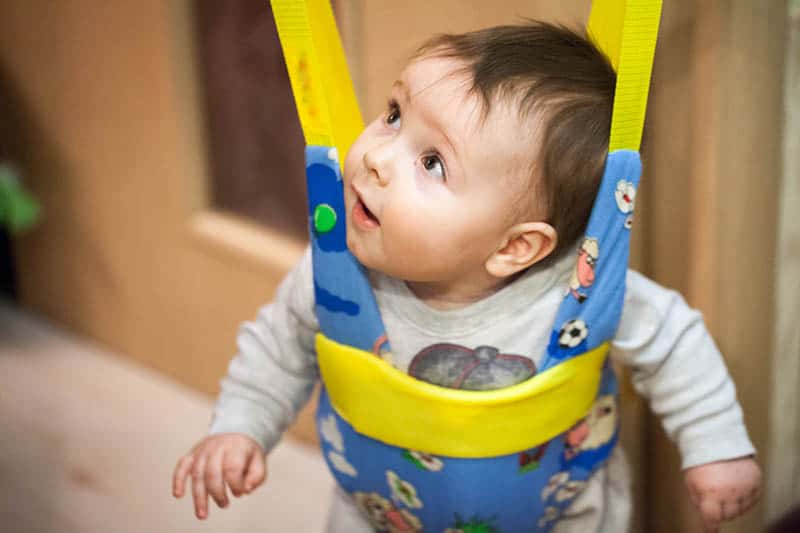
- get used to standing up;
- use her muscles to bounce; and
- have fun on her own!
But a jumperoo is not just a fun baby product to entertain your little one, and it has many benefits as well.
- It gives parents some hands-free time.
- It helps the baby develop muscle strength.
- It contributes to the development of the baby’s fine motor skills through all sorts of fun toys.
Above all, jumperoos are a much safer alternative to products such as baby walkers, which is why you will find them in so many family homes!
Baby Jumper Safety Guidelines
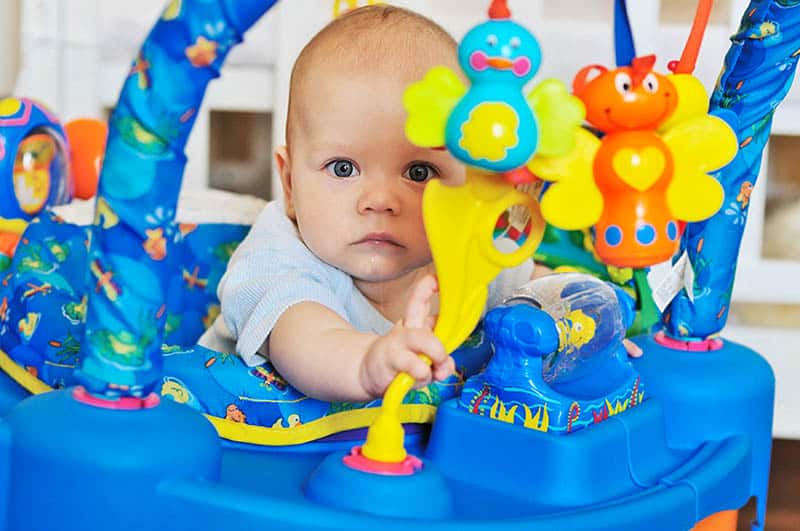
As is the case with kids’ trampolines, infant jumpers also have numerous guidelines regarding safety.
Apart from following the baby jumpers age limit, there are a few other safety guidelines (courtesy of the American Academy of Pediatrics) when it comes to safely using jumpers for babies:
- The jumper should only be used on the floor. Placing the jumper on a table or bed (or any other higher surface) puts your baby at risk of serious injuries if she tips the entire jumper over or tries to climb out on her own;
- Don’t place the baby in the jumper if she has reached the weight/height/age limit of the particular brand you’re using, no matter how much she likes it;
- Stop using the jumper once you notice that your little one’s feet can fully reach the ground as this means she will be able to climb out;
- Don’t leave the room while the baby is in the bouncer and always keep an eye out to see if she is okay. Because they come with all sorts of toys and teethers, your little one could pinch her finger or otherwise do something that needs your intervention, so you should always be close by.
There are also other safety guidelines to consider when using individual jumper models, so don’t throw away the instructions before reading them carefully and making sure you can follow all of them.
How long should a baby use a jumper?
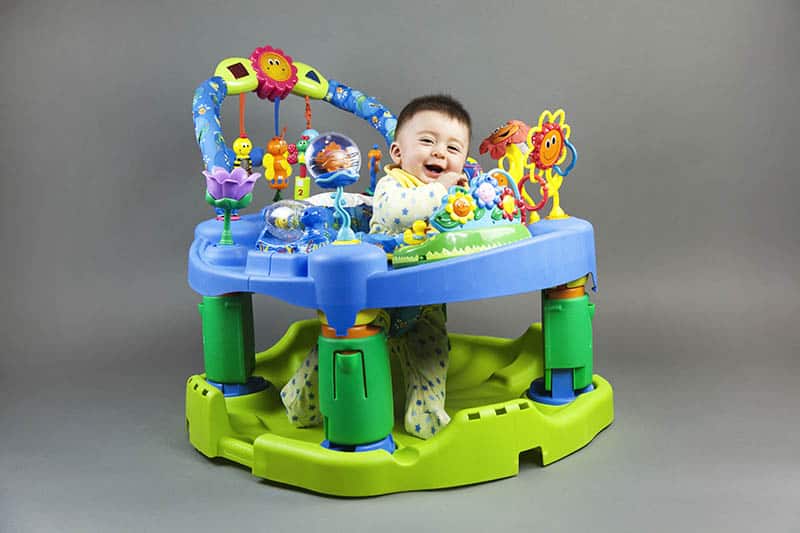
They are really fun, can keep babies entertained, and most importantly, are fixed in one place so that you can have your hands to yourself for a few minutes.
But no matter how much your baby boy or girl loves to bounce, there are some guidelines when it comes to how long a child should be bouncing every day.
You can use the baby bouncer several times a day but no more than 15 minutes at a time.
This is because bouncing around in an activity jumper can’t be compared to actual exercising, such as tummy time, which is very beneficial to a baby’s development and shouldn’t be replaced with a jumper.
What your baby needs at this stage is to develop her motor skills, which is best done by placing her on her tummy for a few minutes every day.
This activity, which some babies love and others dislike, helps strengthen important muscle groups that later allow your little one to start standing up and walking all on her own!
When she is sitting in a jumper, your child still has the support of a seat, so it’s not as good of a “work out” as tummy time where she has to use all her muscles to keep herself lifted.
A Handy Buying Guide
When trying to find the best baby jumper, you will notice that there are many different models available!
And the differences aren’t just aesthetic, they are functional, too.
In addition, some jumpers are safer than others, which is extremely important to know as we all want to avoid accidents – especially with baby products that are meant to be fun!
So, let’s take a look at the main types of jumpers:
1. Freestanding jumpers
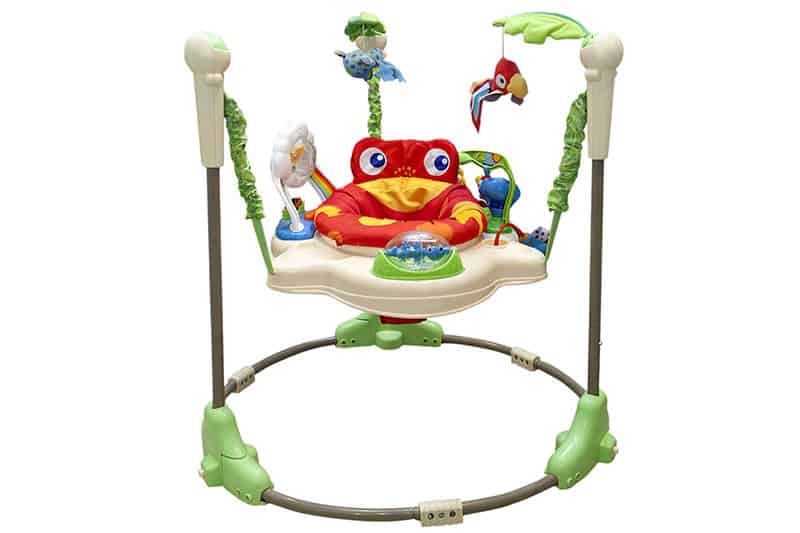
But under this category, you will find many different models that can differ greatly from one another.
If you look up the Jolly Jumper, for example, it looks like 4 metal bars connected at the top, with a hanging seat in the center where the baby sits.
This type doesn’t come with any toys, music, or lights, but it’s very bouncy, which is why babies love it – especially those who are really active!
The baby jumper age limit for some of these models is 3 months, but the baby should be physically developed enough (have good head control, for example) to use it.
As a mom of two, though, I can already see the potential trouble here – the older sibling could try and push the baby like they were in a swing set and that is just the perfect recipe for disaster!
And I’m sure I’m not the only mom who feels just a little bit uncomfortable at the thought of a baby hanging on a spring – call me over-protective but it would be hard to get the thought of the entire construction crashing down out of my mind!
Still, many parents have used such models and never had any trouble so it’s also a matter of personal preference.
When it comes to the second type of freestanding jumpers, think of the Fisher-Price Rainforest Jumperoo.
At first glance, it’s very similar to a baby walker in the sense that there is a seat for the baby, along with a surface with toys, only it’s stationary and the baby can’t wheel herself away.
I’ve always preferred this type because they just seem much sturdier than the other baby jumperoo models.
Plus, they usually come with a height adjustment feature that is really useful as your baby grows.
Since your baby will be seated, and not hanging from a spring, chances of accidents happening are much lower.
Of course, with these models there’s always a bit of cleaning involved – maybe the seat pad gets dirty and needs washing, or some of the toys get chewed on.
Also, these jumpers are much more compact and will fit better if you live in a smaller home where you’re short on space for more baby gear!
Some are even foldable, which is a lifesaver, especially if you’re living in an apartment.
The baby jumper age limit is usually at least 4 months in this case, but it’s still important to check the height and weight requirements to make sure it’s the right fit.
If your little one still can’t quite touch the floor with her feet, you can put a little cushion, pillow, or folded blanket underneath until she gets big enough to go without one.
2. Doorway jumpers
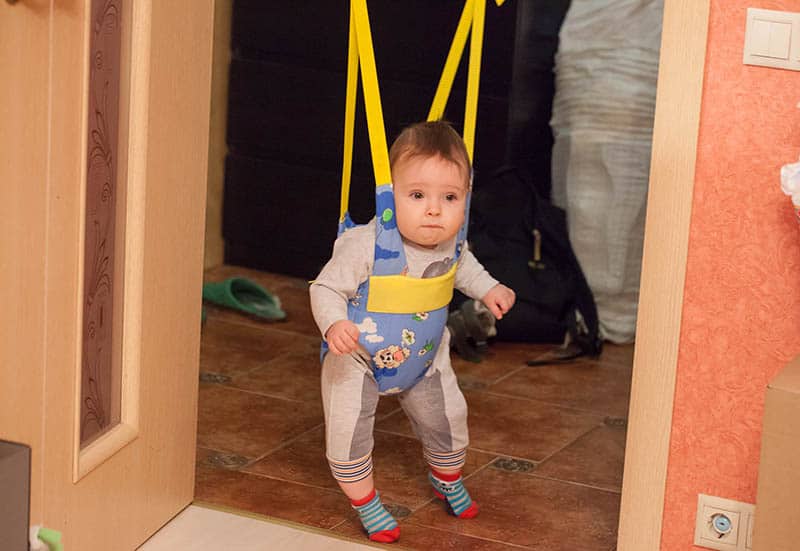
A doorway jumper is used by attaching it to the door frame using a clamp or another gadget, attaching the spring to the seat, and finally, you put the baby in the seat, and that’s it!
Parents love them because they take up little space and can be removed whenever not needed.
They’re also much more low-key design-wise and don’t scream “baby gear.” However, they do come with a risk that the freestanding jumpers do not.
For example, if the baby bounces too vigorously, she may accidentally hit her head against the door frame.
Not to mention that I would be absolutely terrified that the clamp would somehow dislodge itself from the frame of the door!
Plus, these jumpers were made for doors with very specific dimensions, so if your door frame happens to be bigger or smaller than recommended, you’re simply out of luck!
(Although some parents have gotten crafty and found ways of making these bouncers work with door frames with different dimensions…)
Top 3 Baby Jumpers
Now that you’ve gotten the 411 on all things jumperoo, here are some of my favorite models – complete with details on their age, height, and weight limitations!
1. Fisher-Price Rainforest Jumperoo
- Item arrives in frustration-free, easy-to-open packaging that’s 100% recyclable. For a gift-ready box, select “Ship in Amazon packaging” at checkout
- Exciting lights, sounds and music reward your babys every jump
- Infant jumper with 360 degrees of play, including peek-a-boo tiger, bat-at monkey, rattle lizard, and more
- 3 adjustable height positions to grow with your baby
- No doorway required, plus fabric spring covers keep little fingers safe
Prices pulled from the Amazon Product Advertising API on:
Product prices and availability are accurate as of the date/time indicated and are subject to change. Any price and availability information displayed on [relevant Amazon Site(s), as applicable] at the time of purchase will apply to the purchase of this product.
A favorite of baby boys and girls alike, this jumperoo is super colorful and has lots of fun toys and activities for your baby to entertain herself with.
In addition, it includes dazzling music and lights for an extra dose of fun! Your baby will be able to turn every which way in the rotating seat and she can also try to grab at the hanging toys above her head.
You can adjust the height to 3 levels, so the jumperoo will grow with your little one. There is no specific lower age limit for this model but the baby shouldn’t be heavier than 25 pounds and taller than 32 inches when using it.
2. Graco Doorway Bumper Jumper
- Sturdy bounce spring with hidden safety cord for nonstop little leg action and jumping joy
- Easily transports from room to room so that your baby can play anywhere you need to be
- Seat pad is easily machine washable, or wiped clean, to save you time
- Non-twist straps allow quick, easy in and out so you can move baby quickly from room to room
- Height is easily adjusted so it can grow as fast as your baby does
Prices pulled from the Amazon Product Advertising API on:
Product prices and availability are accurate as of the date/time indicated and are subject to change. Any price and availability information displayed on [relevant Amazon Site(s), as applicable] at the time of purchase will apply to the purchase of this product.
If you really like the idea of a doorway jumper, here is a really high-quality model by Graco. While they don’t offer an age range, there is a weight limit of a minimum of 5.5 and a maximum of 25 pounds. When it comes to the height, that can be readjusted as needed.
As is the rule with all jumpers, the baby must have good head control before using the jumper.
Plus, I really love that this jumper comes with toys because this usually isn’t the case with most doorway jumpers!
3. Bright Starts Bounce Bounce Baby
- Unique bounce pad
- 3 height adjustable positions grow with baby
- Seat spins 360 Degree for full access to toys link loop for attaching additional toys
- Fabric Care Instruction Seat pad is machine washable and wipe clean for toy or frame
Prices pulled from the Amazon Product Advertising API on:
Product prices and availability are accurate as of the date/time indicated and are subject to change. Any price and availability information displayed on [relevant Amazon Site(s), as applicable] at the time of purchase will apply to the purchase of this product.
The Bounce Bounce Baby model is very affordable and as such, doesn’t come with as many bells and whistles when compared to its competitors.
Still, it will provide your little one with lots of fun! And the height readjustment feature will make sure she can use it for as long as possible.
The company doesn’t mention anything about age but the jumper does have a 25-pound weight limit!
To Sum Up
Considering that the baby jumper age limit is around 4 months, and parents usually use it for a few short months afterward until the baby outgrows it, knowing whether your little one is old enough for a jumper is a pretty important piece of info.
Not to mention that these baby products can cost a pretty penny, and that’s just another reason to know what baby age for jumper gear is right.
While being the correct age for baby jumper is important, remember to follow the weight and height guidelines, as babies are unique little creatures that can sometimes be taller or heavier than the rest of their age group.
And before your little one takes her seat in her jumper, remember that she should be having fun in it, but that this should be limited to 15 minutes per day to make sure she develops at a healthy pace!
Happy jumping!
References:
“Health Alerts: Infant sleep positioners, bouncer seats, and more” by Trisha Korioth, published on the APP Publications website on October 17, 2017.
READ NEXT: 14 Of The Best Baby Jumpers To Keep Your Baby Active
Like this post? Please share or pin it for later. You can also stay in the loop and follow us on Facebook, Instagram or Pinterest.
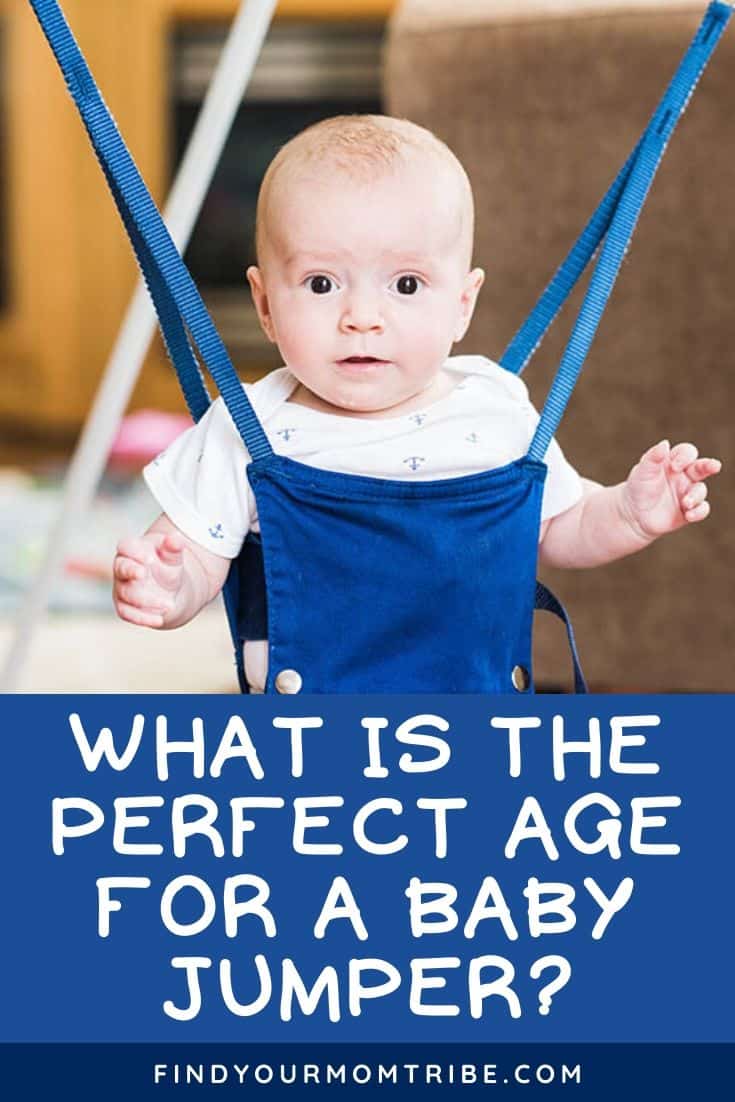
We love honesty! Find Your Mom Tribe is an Amazon Associate and we earn from qualifying purchases through affiliate links at no extra cost to you. Please see our full Amazon Affiliate disclosure for more information.

